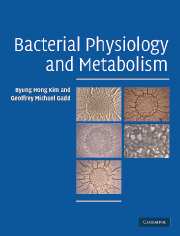Book contents
- Frontmatter
- Contents
- Preface
- 1 Introduction to bacterial physiology and metabolism
- 2 Composition and structure of prokaryotic cells
- 3 Membrane transport – nutrient uptake and protein excretion
- 4 Glycolysis
- 5 Tricarboxylic acid (TCA) cycle, electron transport and oxidative phosphorylation
- 6 Biosynthesis and microbial growth
- 7 Heterotrophic metabolism on substrates other than glucose
- 8 Anaerobic fermentation
- 9 Anaerobic respiration
- 10 Chemolithotrophy
- 11 Photosynthesis
- 12 Metabolic regulation
- 13 Energy, environment and microbial survival
- Index
- References
1 - Introduction to bacterial physiology and metabolism
Published online by Cambridge University Press: 05 September 2012
- Frontmatter
- Contents
- Preface
- 1 Introduction to bacterial physiology and metabolism
- 2 Composition and structure of prokaryotic cells
- 3 Membrane transport – nutrient uptake and protein excretion
- 4 Glycolysis
- 5 Tricarboxylic acid (TCA) cycle, electron transport and oxidative phosphorylation
- 6 Biosynthesis and microbial growth
- 7 Heterotrophic metabolism on substrates other than glucose
- 8 Anaerobic fermentation
- 9 Anaerobic respiration
- 10 Chemolithotrophy
- 11 Photosynthesis
- 12 Metabolic regulation
- 13 Energy, environment and microbial survival
- Index
- References
Summary
The biosphere has been shaped both by physical events and by interactions with the organisms that occupy it. Among living organisms, prokaryotes are much more metabolically diverse than eukaryotes and can also thrive under a variety of extreme conditions where eukaryotes cannot. This is possible because of the wealth of genes, metabolic pathways and molecular processes that are unique to prokaryotic cells. For this reason, prokaryotes are very important in the cycling of elements, including carbon, nitrogen, sulfur and phosphorus, as well as metals and metalloids such as copper, mercury, selenium, arsenic and chromium. A full understanding of the complex biological phenomena that occur in the biosphere therefore requires a deep knowledge of the unique biological processes that occur in this vast prokaryotic world.
After publication in 1995 of the first full DNA sequence of a free-living bacterium, Haemophilus influenzae, whole genome sequences of hundreds of prokaryotes have now been determined and many others are currently being sequenced (www.genomesonline.org/). Our knowledge of the whole genome profoundly influences all aspects of microbiology. Determination of entire genome sequences, however, is only a first step in fully understanding the properties of an organism and the environment in which the organism lives. The functions encoded by these sequences need to be elucidated to give biochemical, physiological and ecological meaning to the information. Furthermore, sequence analysis indicates that the biological functions of substantial portions of complete genomes are so far unknown.
- Type
- Chapter
- Information
- Bacterial Physiology and Metabolism , pp. 1 - 6Publisher: Cambridge University PressPrint publication year: 2008



